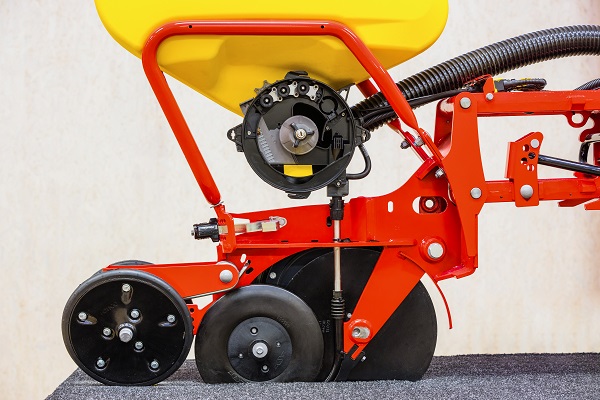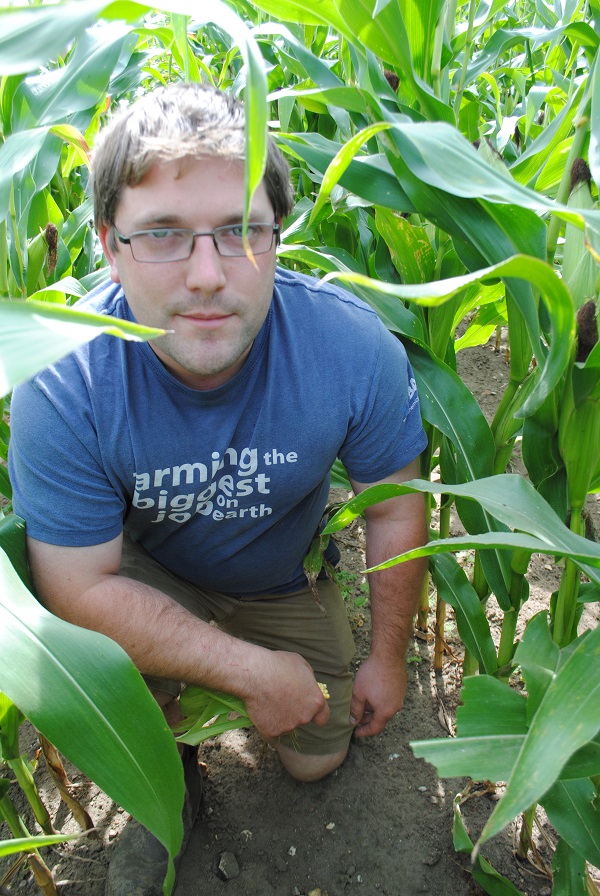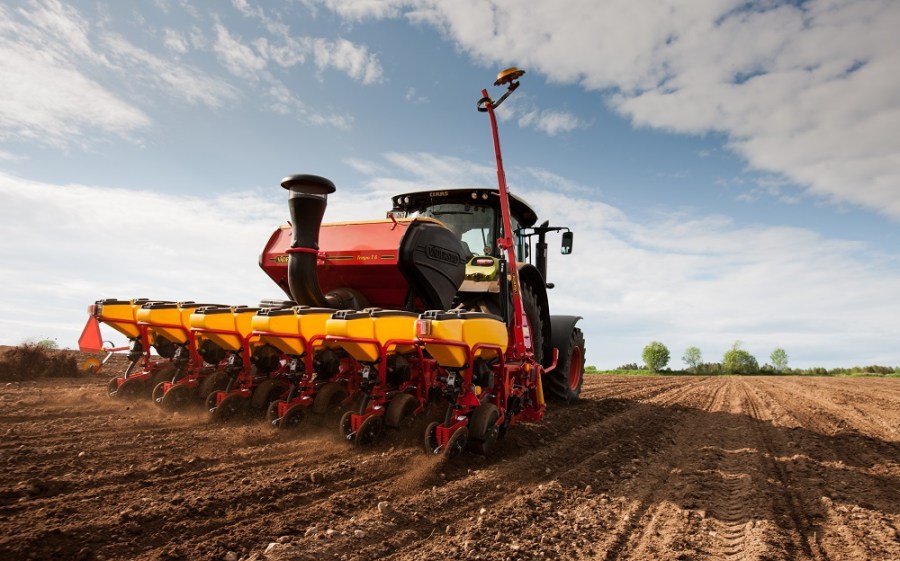Precision planting is an important aspect of good maize establishment, but how does this fit in with the low cost, high output system required in combinable crops? CPM visits a Norfolk farming business to find out.
By Rob Jones
While maize is proving to be a valuable cropping option for many growers in the Eastern Counties, establishment can pose a problem. Seed-depth accuracy and spacing are widely advised as absolutely crucial factors to ensure a good plant stand and to optimise yield – more so than in combinable crops.
So it was the purchase of a high-speed precision seed-drill that helped Norfolk contractor and arable farmer Charles Saffell of H C Beales and Co develop his contract maize business. He says his six-row Väderstad Tempo T drill he bought last year ensures exact seed depth and spacing to such an extent it’s given him a competitive advantage over other contractors.

One of the key features of the Gilstring seed meter is the pressurised PowerShoot seed transport, that blows the seed to the coulter.
The family farming partnership was started by Henry Beales and currently runs to 240ha of combinable crops plus sugar beet based at Crown Farm, Great Ellingham. A share farming arrangement with a neighbouring farmer E F Shingfield and Son adds a further 400ha. All machinery purchases across both farming enterprises are owned on a 50:50 basis.
Cropping on the home farm includes oilseed rape 90ha, sugar beet 90ha, 150ha winter wheat, winter barley 25ha, potatoes 40ha and vining peas 30ha. Soil types are predominantly medium loam to heavy clay, which achieve an average wheat (Santiago) yield of 10t/ha.
“Most stubbles are cultivated with a 4m Väderstad TopDown to produce a stale seedbed before burning off with glyphosate,” says Charles Saffell. “We’re trying to avoid using the plough because the price of wheat just doesn’t justify having one. We do have some blackgrass but we’re on top of it by double spring-cropping worst affected areas.”
Two years ago, he introduced 360ha of contract maize, grown for anaerobic digesters, into the farming operation. This is spread across six different farming operations including 60ha on E F Shingfield’s land and 10ha on the home farm. The crop fits in well with the farming system, both in terms of rotational benefits and machinery utilisation, says Charles Saffell.

Charles Saffell has seen prospects for his maize contract business grow following the purchase of his Tempo T precision drill.
“The majority of cultivations are carried out in the winter, freeing up the spring to concentrate on the maize operation. After maize we move into grass silage followed by wholecrop rye, before the cereal harvest starts and then the maize in mid Sept.”
Drilling the maize posed something of a problem, however – an existing 12-row Accord drill was used for establishing the farm’s sugar beet acreage, but it couldn’t drill maize. That’s what led the farming partnership to purchase a six-row Väderstad Tempo T precision air drill – it offered the flexibility of drilling not only both sugar beet and maize, but potentially also OSR, and all of this could be carried out at speed.
“Our Accord was only three years old but it couldn’t drill all the crops we needed it to and those that it could drill, it couldn’t drill at 15km/h or accurately enough. Output hasn’t been compromised having gone from a 12 to six-row machine because the speed has doubled.
“Seed placement and seed-depth accuracy has much improved since switching to the Tempo T. On sugar beet we’re now achieving at least 90% establishment compared with about 80% with the Accord.
“We’ve looked at crops established with other drills in the area, but they’re not a patch on the Tempo. We feel that the drill gives us a competitive edge,” says Charles Saffell.
“We tried a Kverneland seed drill as an alternative but the seed placement was an issue. We also work very closely with our local Väderstad dealer and help deliver his kit around the area.”
The Tempo T can drill in virtually any condition and cultivation system he says. This is an advantage because his customers use a multitude of establishment systems based on no-till, min tillage and the plough.
“The configuration of the seed unit makes it possible to drill in virtually any condition. It’s heavy and well regulated to ensure it doesn’t lift out of the ground on light land, while on the heavier soils the weight helps to push the unit into the ground. The depth is therefore kept constant at about two inches (50mm).”
Accurate seed depth is achieved with the Tempo T despite travelling at forward speeds of over 16km/h. Linked to the three-point linkage on the tractor, Charles Saffell explains that the drill travels well with a much tighter turning circle on the headlands than an equivalent drawbar mounted drill.
A compact drill, the Tempo T has a 1t fertiliser hopper and independent coulter system that’s positioned at the front of the drill, where it carries out a small amount of cultivation by slicing up clods before the seed coulter accurately places the seed. Fertiliser placement can be altered to suit different crops by adjusting the cutting angle of the disc.
PowerShoot technology, that uses air pressure to ‘shoot’ the seed down the pipe, makes the coulter insensitive to vibrations, says Väderstad, so drilling accuracy isn’t compromised at higher speeds. The seed meter is made of aluminium and has an emptying hatch for easy cleaning when changing crops.
“The Accord is a gravity and electric-fed seed drill that just isn’t as accurate as the air-assisted Tempo,” says Charles Saffell. “Applying seed and fertiliser at the same time cuts out one pass and saves about £22/ha – equivalent to around £8000/yr in establishment costs.
“When we bought our six-row machine, the 12-row version wasn’t available and this would have saved us even more money on establishment costs. It has a front mounted fertiliser hopper which is slightly more complicated and time consuming to take off.”
Despite the smaller capacity six-row machine, he says he confidently expects it to achieve at least 800ha/yr. “The market for AD plants is growing slowly but if we were able to get another 400ha of contract maize we might trade the six-row in for a 12-row Tempo.”
The Tempo T is pulled with the firm’s Fendt tractor which uses about 120 l/day of fuel and is controlled via a Bluetooth-compatible Väderstad iPad.
“Väderstad supplied the iPad holder which sits on a bracket in the cab,” says Charles Saffell. “It can also be used to run the new version of the Rapid drill, but ours isn’t old enough to change yet.”
Farm facts
H C Beales and Co, Crown Farm, Great Ellingham, Norfolk
- Area farmed: 525ha + 400ha share farmed + 290ha contract maize
- Cropping: winter wheat, oilseed rape, sugar beet, vining peas, winter barley
- Soil type: medium loam to heavy clay
- Forage harvester: John Deere 8600
Share-farmed machinery portfolio:
- Combine: Claas 750 Lexion with 9.1m header
- Mainline tractors: Fendt 828 and 724, JCB 4220 Fastrac
- Drills: 6m Väderstad Rapid, six-row Väderstad Tempo
- Cultivations: 4m Väderstad TopDown, 4.6m Simba Xpress, 6f Kverneland plough, 3m Sumo Trio, 12m rolls
- Sprayer: 36m Landquip trailed




